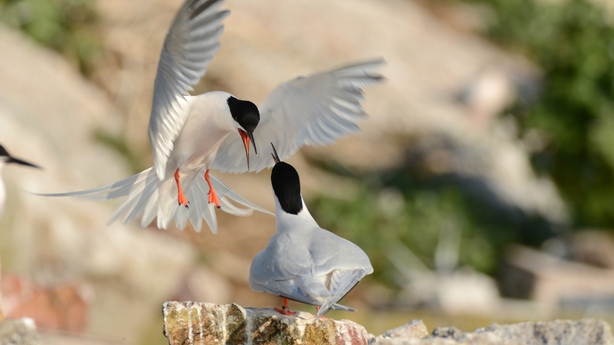Nest boxes deployed on a small island off the coast of Dublin are greatly helping Europe's largest colony of Roseate Terns, new research shows.
Rockabill island, which is the size of a football pitch, is home to 85% of the European population of the bird.
The number of breeding pairs is now ten times what it was when BirdWatch Ireland started a conservation project on the island in 1989.
Chicks that hatched and fledged on Rockabill have gone on to boost other important colonies in Wexford and England.
Every year for the past 33 years wardens have been placing hundreds of wooden nest boxes on the island providing the terns with secure spaces to nest.
Scientists hoped the boxes would provide additional shelter, but by analysing 15 years of data comparing the impact of traditional open nests with nests in the boxes, they found their strategy was having an even bigger positive effect.
Dr O'Connell, who conducted data analyses during his PhD in Trinity’s School of Natural Sciences and is now a Research Fellow at University College Dublin, said: "These sorts of follow-up analyses are really important as they look into how successful any conservation actions have been and let scientists know whether they are putting effort into the right areas.
"It is fantastic to have found that over three decades of a hard manual slog by BirdWatch Ireland wardens – during which time they put out hundreds of nest boxes on the island each year – was more than worth it.
"What seems like a simple conservation strategy is proving to be very effective by having a really positive impact on Roseate Tern breeding."

Dr O'Connell is co-author of a research article, published today in the journal Ecological Solutions and Evidence, which shows that the nest boxes helped the terns have much more success in raising their young - more eggs hatched and more chicks survived to fledge into juveniles when they were born in the boxes.
This suggests the nest boxes help protect the terns from bad weather, predators and even from squabbles with neighbours, while also making the best use of limited space on the island by allowing for a much higher density of nests.
Like most seabirds, Roseate Terns nest on the ground, but whereas most tern species prefer open areas to lay their eggs, Roseate Terns nest in sheltered spots, usually under vegetation or beside rocky overhangs or in crevices.
They like their nests to be hidden from above and from a distance to protect them from predators and poor weather.

Brian Burke, Scientific Officer with BirdWatch Ireland and another co-author of the journal article, was a Rockabill warden for three years.
He said the birds were in decline across the Irish and UK coasts in the 1980s, so a project was set up on Rockbill where the biggest colony was.
Speaking on RTÉ's Morning Ireland, Mr Burke said that when the lighthouse keepers moved off the island and the lighthouse was automated, a decision was made between Birdwatch Ireland and the National Parks and Wildlife Service to put wardens there during the summer.
Nest boxes were placed in sheltered areas and there are now 1,700 pairs of Roseate Terns there, which is 85% of the European population.
"So without Rockabill, there probably wouldn't be any Roseate Terns in Europe."
Mr Burke said there are also 2,000 pairs of common terns on the island, and about 10,000 birds in total.
"It's a long-term conservation project and when things are funded in the long term, it gives it the chance to try things and some things don't work and some things do work," he said.
"And when they do work, you know the payoff is absolutely huge".
The nest boxes deployed by the wardens are cheap and easy to make and many have been made and colourfuly decorated by students in Balbriggan Community College.
The conservation of Roseate Terns on Rockabill is funded by the National Parks and Wildlife Service of the Department of Housing, Local Government and Heritage and delivered by BirdWatch Ireland.

